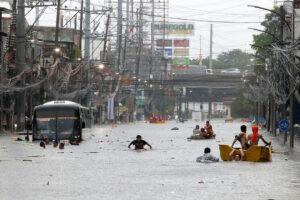By Vonn Andrei E. Villamiel, Reporter
THE Department of Public Works and Highways (DPWH) accessed a major portion of the climate mitigation budget over the past five years, channeling it to flood control and drainage projects, Aksyon Klima Pilipinas (AKP) said in a report.
AKP said between 2020 and 2025, physical infrastructure was a major spending item in the Philippines’ climate-mitigation effort, with funding was channeled into flood mitigation systems, road rehabilitation, and re-silient-building construction works managed by the DPWH.
In 2025, 31.8% of the P1.15-trillion climate budget was allocated to address the “water sufficiency” goal of the National Climate Change Action Plan (NCCAP), with P354.1 billion earmarked specifically for flood control and drainage projects.
The Philippines tracks climate-related spending through Climate Change Expenditure Tagging (CCET), a system that classifies government projects aligned with the NCCAP, the roadmap for climate adaptation and mitigation.
While the budget allocation for CCET-tagged projects surpassed P1 trillion for the first time in 2025, AKP National Coordinator John Leo Algo said in a briefing that the focus on infrastructure left other critical climate priorities underfunded.
“From the perspective of communities affected by the impacts of the climate crisis, at first glance, we might consider that the administration is fulfilling its promise to make the climate crisis a priority. But we need to look at the quality, not just quantity,” Mr. Algo said.
The DPWH accounted for 75% of all climate-related expenditure between 2020 and 2023, with nearly all of the agency’s projects tagged as climate adaptation measures.
The report said the heavy infrastructure focus sidelined other critical items such as agriculture, freshwater resources, and renewable energy.
“Only a small percentage of the climate budget goes to critical agencies for adaptation, like the Department of Agriculture, the Department of Environment and Natural Resources, and an even smaller portion goes to na-ture-based solutions like ecosystem restoration and protection,“ Mattie Balagat, training and community services coordinator of the Center for Environmental Concerns-Philippines, said.
In 2025, programs for “ecosystems and environmental stability” received just 1.8% of the budget given to flood control infrastructure. Projects for the rehabilitation of degraded watersheds and forests were allotted only P3.4 million.
Following the DPWH corruption scandal, President Ferdinand R. Marcos, Jr. canceled all new flood control projects in the proposed 2026 national budget. They were initially allocated P983.8 billion, about 15% lower than in 2025.
AKP said that the CCET system must be strengthened to guarantee that government-funded programs, projects, and activities genuinely support the NCCAP and the Philippines’ climate commitments.
“More public funds should go towards environmental protection and conservation, and genuine climate actions, especially nature-based solutions. They are more cost-effective and even have co-benefits,” Mr. Lago said.
The group is also calling on the government to improve climate risk assessment and proactively investigate greenwashing and corruption in physical infrastructure projects beyond flood control.

